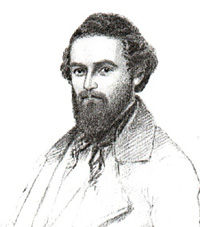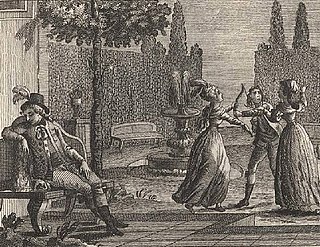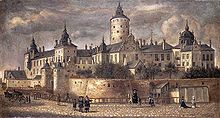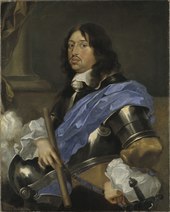
Axel Gustafsson Oxenstierna of Södermöre, Count of Södermöre, was a Swedish statesman. He became a member of the Swedish Privy Council in 1609 and served as Lord High Chancellor of Sweden from 1612 until his death. He was a confidant of King Gustavus Adolphus and then Queen Christina, of whom he was at first regent.

Christina was a member of the House of Vasa, and the Queen of Sweden in her own right from 1632 until her abdication in 1654. She succeeded her father Gustavus Adolphus upon his death at the Battle of Lützen in 1632, but began ruling the Swedish Empire when she reached the age of eighteen in 1644.

Un ballo in maschera is an 1859 opera in three acts by Giuseppe Verdi. The text, by Antonio Somma, was based on Eugène Scribe's libretto for Daniel Auber's 1833 five act opera, Gustave III, ou Le bal masqué.

Renata Tebaldi was an Italian lirico-spinto soprano popular in the post-war period, and especially prominent as one of the stars of La Scala, San Carlo and, especially, the Metropolitan Opera. Often considered among the great opera singers of the 20th century, she focused primarily on the verismo roles of the lyric and dramatic repertoires. Italian conductor Arturo Toscanini called her voice "la voce d'angelo", and La Scala music director Riccardo Muti called her "one of the greatest performers with one of the most extraordinary voices in the field of opera."

Eduardo e Cristina is an operatic dramma in two acts by Gioachino Rossini to an Italian libretto originally written by Giovanni Schmidt for Odoardo e Cristina (1810), an opera by Stefano Pavesi, and adapted for Rossini by Andrea Leone Tottola and Gherardo Bevilacqua-Aldobrandini.

Domenico Reina was a Swiss bel canto tenor, notable for creating roles in the operas of Vincenzo Bellini, Gaetano Donizetti, Saverio Mercadante, and other Italian composers.

Giuseppe Lillo was an Italian composer. He is best known for his operas which followed in the same vein of Gioachino Rossini. He also produced works for solo piano, a small amount of sacred music, and some chamber music.

Rita Orlandi-Malaspina was an Italian operatic soprano who had a major international career from the 1960s through the 1980s. She drew particular acclaim for her portrayals of Verdi heroines. She also had a successful career as a concert soprano, particularly in performance of Verdi's Requiem and Ludwig van Beethoven's Symphony No. 9.
Gustavo III is an opera by Giuseppe Verdi to a libretto begun in early 1857 by the Italian playwright Antonio Somma. Never performed as written, the libretto was later revised several times under two additional names – Una vendetta in dominò and Adelia degli Adimari – during which the setting was changed to vastly different locations. Eventually, it was agreed that it could be called Un ballo in maschera, the one by which it is known today, but Verdi was forced to accept that the location of the story would have to be Colonial Boston. This setting became the "standard" one until the mid-20th Century. Most productions today locate the action in Sweden.
Andrea Salvadori was an Italian poet and librettist. He was born in Florence and educated at the Collegio Romano in Rome. From 1616 until his death in Florence at the age of 43, he was the principal court poet to the Medici family. In addition to numerous theatrical entertainments and poems, he wrote the libretti for five operas, four of which have survived, although only La Flora composed by Marco da Gagliano and Jacopo Peri has an extant score. He was married twice, first to Emilia Rigogli by whom he had three sons and then to the painter Alessandra Furini. A collection of Salvadori's principal works curated by his son Francesco was published in 1668.

Francesco Maria Santinelli (1627-1697) was an Italian marquis, count, Marinist poet, librettist and alchemist. In Senigallia, Christina, Queen of Sweden was welcomed in verse by the handsome Santinelli and his brother, Ludovico, an acrobat and dancer. Both seem to have been accomplished scoundrels. A year later Ludovico was witness and participant at the murder of Gian Rinaldo Monaldeschi at Fontainebleau. After the scandal, she promised Pierre Chanut that Ludivico and his two helpers would have to leave her court.

Jacopo Foroni was an Italian opera composer and conductor who spent most of his working life in Sweden.
Stephen Medcalf is a British stage director, particularly known for his opera productions, both in the UK and abroad. He received the Italian music critics' prize, Premio Abbiati, for "Best Director" in 2005. Medcalf is married to the British soprano Susan Gritton.

Vincenzo Negrini was an Italian bass-baritone opera singer. Born in Cesena, he sang leading bass and baritone roles in Italy's major opera houses and created several roles in early 19th-century operas, most notably Oroveso in Bellini's Norma and Folco in Donizetti's Ugo, conte di Parigi. Severe heart disease caused him to retire from the stage in June 1840. He died in Milan two months later at the age of 35.
Vincenzo Galli was an Italian opera singer and impresario. Considered an outstanding basso buffo singer, he created many roles on Italian stages, including in two of Donizetti's operas: Ivano in Otto mesi in due ore and Cesare Salzapariglia in Le convenienze ed inconvenienze teatrali. Luigi Ricci composed the role of Michelotto in his opera Chiara di Rosembergh specifically for Galli's voice.

Il bravo, ossia La Veneziana is an opera in three acts by Saverio Mercadante to an Italian-language libretto by Gaetano Rossi and Marco Marcello. Their libretto was based on the play La Vénétienne by Auguste Anicet-Bourgeois, which was in turn based on James Fenimore Cooper's novel The Bravo. The opera premiered on 9 March 1839 at La Scala, Milan and subsequently played throughout Italy and abroad. The opera was still being occasionally performed and recorded in the 20th century. and was hailed as an "exciting rediscovery" when it was staged by the Wexford Festival in 2018.

Gustavo primo, re di Svezia is a three act opera seria by Baldassare Galuppi, with a libretto by Carlo Goldoni, fictionalising events in the life of Gustav I of Sweden. Composed in honour of the Genoese nobleman marchese Giovanni Giacomo Grimaldi, it premiered on 25 May 1740 at Venice's Teatro San Samuele. It was first recorded in 2003 by Edit Károly, Mónika Gonzalez, Mario Cecchetti, Gabriella Létai Kiss, Filippo Pina Castiglioni, and the Savaria Baroque Orchestra, conducted by Fabio Pirona.
Helena Dix is an Australian operatic soprano and specialist in bel canto roles. In 2005 Dix represented Australia in BBC Cardiff Singer of the World. She was awarded as an associate of The Royal Academy of Music in 2015 for her significant contribution to the music industry.

Daniel Mattias Johansson is a Swedish operatic and concert tenor. He became a hovsångare, or a Swedish "Court Singer", in 2018.

Paula Maria Lindberg Lizell née Frödin (1873–1962) was a Swedish operatic soprano. She made her debut in 1893 at the Royal Swedish Opera as Mathilde in Rossini's William Tell, becoming one of the company's leading sopranos until she retired from the stage in 1911. After first appearing in coloratura roles, she sang in more dramatic works such as the Wagnerian operas where she appeared as Senta and Sieglinde. She later worked as a drama teacher for singers.


















